New partnership announced with Borderless
Sona and Borderless announce an exciting partnership.
Building a staff schedule couldn’t be easier.
Reduce payroll errors with real-time T&A.
Fill 50% more shifts with your own employees.
Ensure shifts are covered even if you're understaffed.
Manage absence requests and approvals.
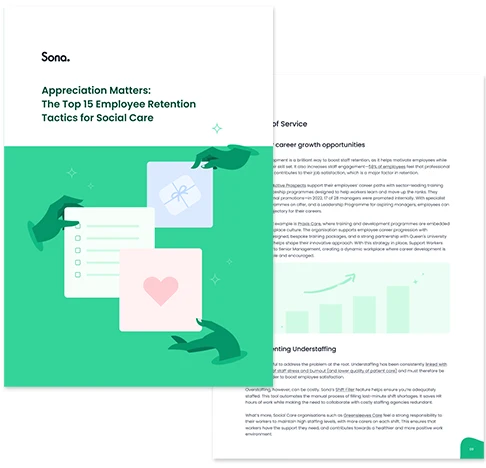
Practical ways to boost team morale with proven examples from across the sector.
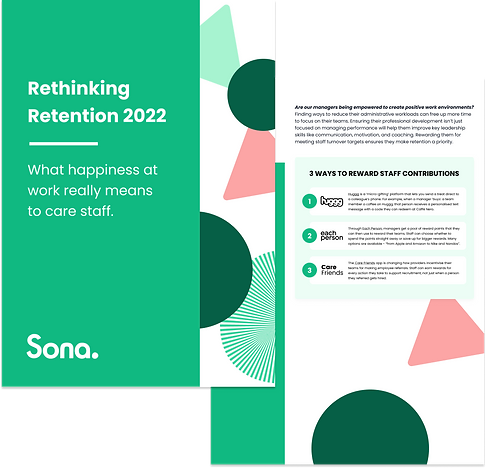
Find out what care employees say matters to them most at work.
Search and view employees with customised permission levels.
Key employment information all in one place.
Store visas, professional certifications and more with easy access.
Control personal and operational details of your staff.
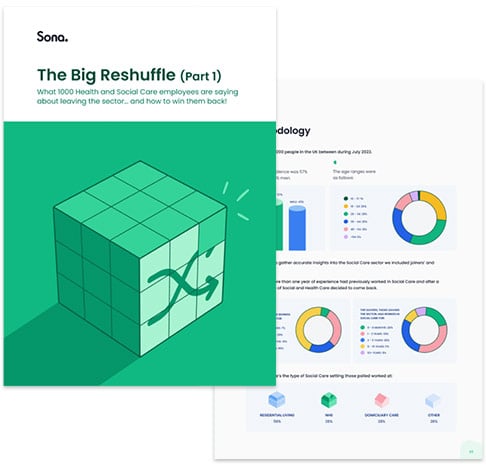
Why are people leaving Social Care, and where are they going?
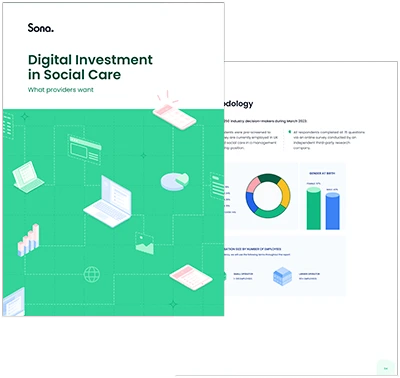
We asked 250 Social Care leaders about their attitudes towards digitisation and their plans for the next 12 months...
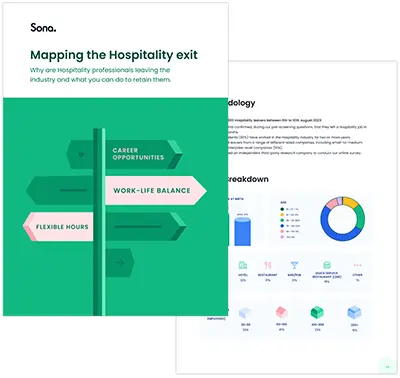
Why are Hospitality workers leaving the industry, and what can you do to retain them?
Share updates with a single click.

Staff can see relevant messages in one place.
Request post-shift feedback from staff.
Recognise staff contributions by sending them praise.
Identify staff at risk of churning.
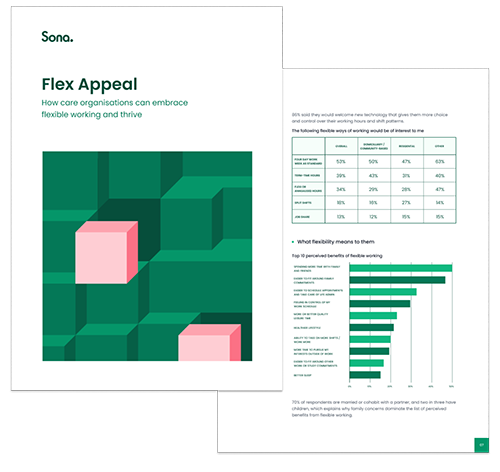
How care organisations can embrace flexible working and thrive.
Maintain quality of care and reduce costs.
Maximise profitability through AI-powered forecasting & scheduling.
Elevate your operational efficiency and guest satisfaction.
Streamline operations across sites.
Developed alongside Social Care experts with decades of combined experience.
See why we are the leading user-friendly, end-to-end platform that prioritises both efficiency and wellbeing.
The Sona Partner Network is an ecosystem of solution experts and complementary technologies.
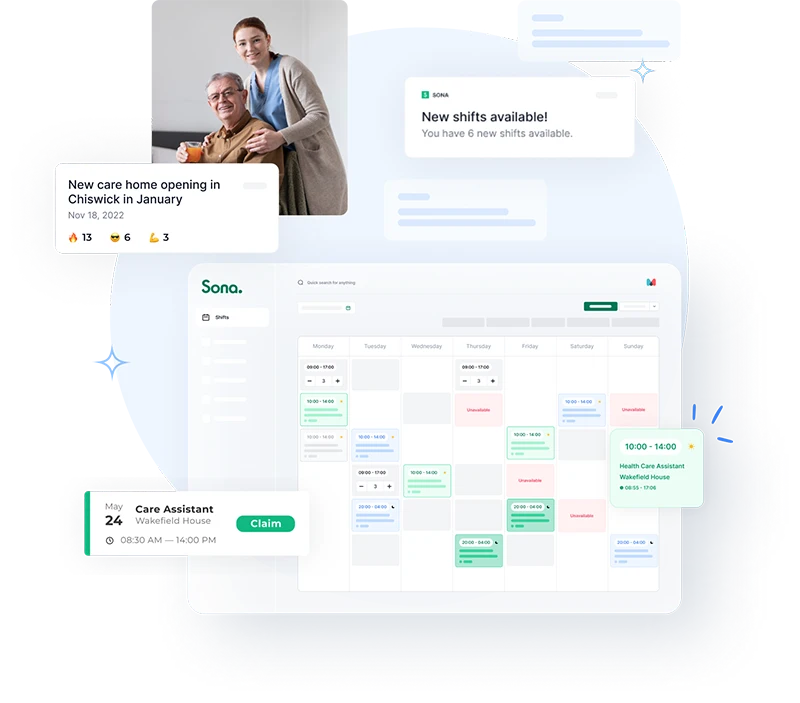
Give staff greater visibility of shifts available to work, with a simple "shift claim" process to increase their income.
Improve employee engagement and retention with a seamless employee communication platform.
Happier staff provide greater customer experiences, which in turn drives return rates, revenues and recommendations.
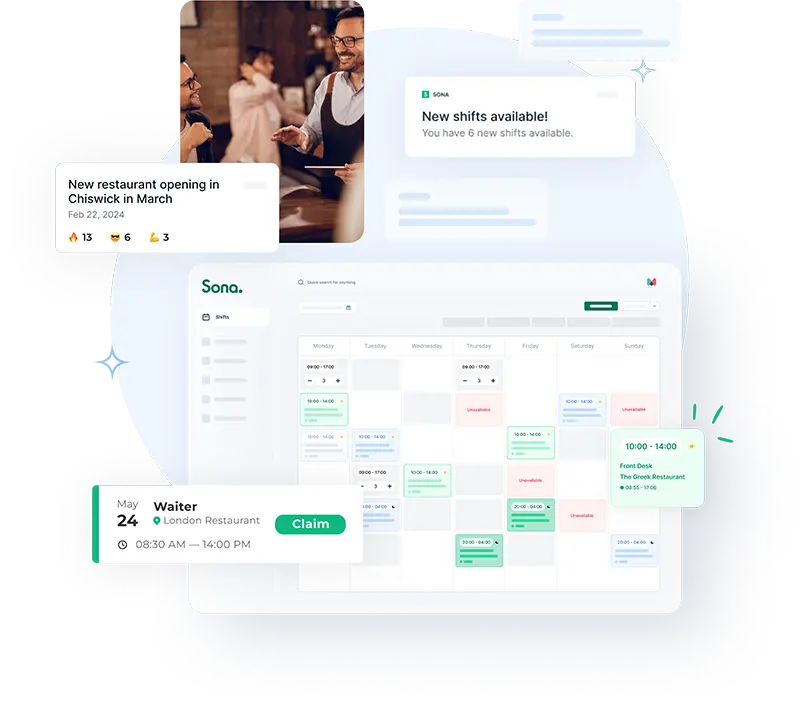
Give staff greater visibility of shifts available to work, with a simple "shift claim" process to increase their income.
Improve employee engagement and retention with a seamless employee communication platform.
Happier staff provide greater customer experiences, which in turn drives return rates, revenues and recommendations.

Meet the Sona team online with our webinar series or in-person at an event near you.
New research, insights, and strategies for frontline leaders.
Downloadable templates, reports and guides from Sona.
Stay up to date with the latest Sona news and research.
Learn how our customers are transforming their people operations.
| 3 min read
Sona and Borderless announce an exciting partnership.
| 2 min read
Sona and Found by Lottie announce an exciting partnership.
| 4 min read
Remove operational errors, drive efficiency, and help your team spend less time on admin with a unified solution.
PUBLISHED: February 2025
Download the report to learn how hospitality operators are embracing AI challenges and opportunities in 2025.
PUBLISHED: January 2025
Reveal the most important metrics in 2025!
PUBLISHED: December 2024
This infosheet is packed with practical insights to drive high-quality, low-regret WFM purchases.
Contents
Digital transformation offers large Hotel groups an opportunity to become more efficient and make better use of their existing resources, so that every area of the business can thrive.
This guide will be of particular use to C-level executives in People, Change Management, Technology, and Operations roles.
With the right plan, choosing tech is not a leap of faith, but the safest short-term investment in long-term success.
With the complexity associated with a large Hotel group, gaining a wholistic view of your tech stack can be more complicated than it first appears.
Capturing how solutions interact will yield the most accurate view of the current infrastructure and how it impacts efficiency.

Confirm your email address to download this tech map as a PDF
Start by listing out how many providers you work with currently, then match them to the circles on this map.
Organise the providers according to the services they deliver. If a provider delivers more than one service, add both in each corresponding category.
Connect each service with different lines to highlight if and how they communicate.
For example, if the HR solution is integrated with the Payroll solution and information about shifts and holidays moves freely without teams having to enter the data twice, then the two will be connected by a double-headed arrow.
Tech stack inefficiencies are a drain on both financial and personnel resources. To identify them, ask individual departments:
The spotlight is once again on the need for top line growth and smarter cost control to maintain or improve profitability for UK Hotels.
PwC UK Hotel Report, 2024
Every Hotel operator will aim for growth as a business goal, but with UK demand forecasted to stall in 2024, efficiency and intelligent labour deployment will be the safest investment for long-term success. Having the correct tech stack is key to hitting these KPIs.
Labour productivity and time saving tools are not new on the market, but technology evolves at a rapid pace. Many tech contracts span multiple years and if a provider is not constantly improving, that means it may be falling behind.
So, the first - and arguably most important - consideration when deciding on new tech is to ask: how will the tech impact the bottom line and when?
All vendors will claim to improve efficiency. Leadership teams are responsible for investigating and validating that claim - particularly when it comes to Artificial Intelligence.
AI features entered the market with the promise of delivering accurate demand forecasts, automated workflows, and maximum efficiency. This is the genuine potential of the technology; however, legacy tech was at the time limited by its foundation in outdated code and programming practices.
Next-generation AI for Hotel management is built on modern, scalable code that uses machine learning capabilities similar to what powers generative tools like ChatGPT. Looking to new technology such as this can help leadership teams bridge the gap between the need for growth and a stalling demand.
With the above distinctions in mind and the tech ecosystem, these questions should help teams conceptualise how different solutions will remove friction and unlock growth - while also preventing choices that will add complications later down the line.
What to ask tech vendors when reviewing solutions:
A scheduling solution will increase efficiency in Operations and Labour Productivity departments, but if it doesn't integrate seamlessly with an HR or Payroll solution, the People and Finance departments will lose efficiency as a result.
Guest experience solutions won't yield direct gains, but the positive touchpoints will ideally compound into increased loyalty which will then lead to growth. However, if your goal is a quantifiable ROI per solution, then managing labour costs will be the most important lever, with scheduling, HR, payroll, and team engagement solutions as the highlights.
Robustness refers to any incident that might cause your business to incur losses or financial risks, so enquiring about the provider's history of good service is essential.
Scalability is a means of future-proofing your business. A great solution should serve the needs of your business right now, as well as five years from now. For example, if your group acquires an additional 50 properties, will the scheduling provider be able to accommodate the increase in users?
Sona has given us the confidence to grow. What it’s allowed us to do is not use resources and processes as a barrier, so whereas before we may have said ‘Actually, if we’ve got three opportunities [for acquisition], we’ll only take one because it’s going to take some time to bring it on board, we’re going to have to bring in our processes.’ We can now say ‘We’ll take all three,’ because we know we can take them and streamline them into our processes, no problem, and while we’re doing that, we can go and look for the next ones rather than have the team’s entire focus be on a laborious implementation process.
Claire Bunker, Growth and Development Director
Complex solutions will provide a wealth of data, but leadership teams will need insights rather than simple information. AI should be able to bridge this gap and produce instantly relevant dashboards such as gender pay gaps, tronc reports, forecasting notices, and more.
Some solutions will enable quicker reactive strategies when the situation demands it, whilst others are geared towards building predictability and consistency into the organisational structure.
Demand forecasting powered by machine learning AI is an example of tech that helps organisations be proactive in their team deployment, hiring, and resource planning. This will reflect in both efficiency and guest experience, as well as employee job satisfaction.

The end-to-end employee experience will impact recruitment and retention and, consequently, a Hotel group's ability to deliver excellent service. Researching what your team members need from an employee platform and the feedback each vendor receives from staff will help with getting team buy-in for any new solution.

Non-sector specific solutions can work well in some areas of the ecosystem, but a vendor that specialises in Hotel operations complexities will be able to offer more support and a higher degree of customisation.
A vendor's commitment to the Hotel sector will also show in their partners, as multi-sector solutions often don't integrate with single-sector tech.
Reviewing a vendor’s feedback and history of successful implementation, their roll-out documentation, and their support response times will help leadership teams understand what their experience will look like once they sign with a new provider. Requesting to meet Implementation and Support leaders whilst still in the sales process can help with this appraisal.
A successful roll-out for any part of the tech stack is decided by how committed both the vendor and the operator are to the process.
A quality vendor will be able to share with the leadership team detailed roll-out schedules and will have requests for which roles need to be points of contact on the operator side.
Additionally, they should be transparent about what data the operator will need to provide before the implementation can start. For example, transitioning to a new HR system will require all previous employee documentation to be ready to upload into the new solution. This way, operators can be proactive about the process and ensure they have the right people working on the deployment project.
In the buying process, leadership teams can assess a vendor’s implementation capabilities by asking:
Navigating the complex landscape of Hotel tech requires a strategic and informed approach. Operators must first understand their current tech stack, identify inefficiencies, and align their technology choices with business goals.
By carefully evaluating and selecting the right solutions, particularly those that leverage modern AI capabilities, operators can bridge the gap between operational efficiency and growth, even in a challenging market environment.
The right technology, supported by strong vendor partnerships and a commitment to seamless implementation, will empower leadership teams to enhance guest experiences, improve employee satisfaction, and ultimately drive profitability.
If you would like to discuss your tech stack and see how it compares to other Hotel groups, book a 15-minute free consultation below.
Legacy agnostic systems were introduced in the early 2000s. These systems feature in every sector and represent a significant upgrade from paper and spreadsheets. They allow managers to share schedules with their teams faster and safer than before.
They introduced the copy and paste calendar-style schedule templates which inspired the customisable templates of later generations. These templates help larger companies better manage the schedules of thousands of staff and reduce the time needed to do it.
Cloud software developments in the late 2010s made it possible for staff to keep updated on their schedules anytime without the need to install software on a computer. Coupled with the proliferation of mobile apps during the same time period, Gen 2 represented an upgraded WFM ecosystem.
Organisations of different sizes across multiple sectors benefit from the flexibility Gen 2 offers. User experience improved which meant shorter training time and fewer software specialists.
Next-generation solutions have grown organically from the learnings of Gen 1 and Gen 2. Combined with their focus on deep sector expertise, the result is a sector-specific, cloud-based system designed with consumer-grade UX.
This signals the end of stand-alone point solutions. Instead, the goal becomes integrating scheduling completely with HR, Payroll, Communications, and more. Workflows for staff at every level of an organisation work in harmony with a holistic end-to-end experience.